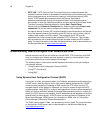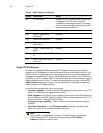
4 Chapter 2
• PPTP VPN - PPTP (Point-to-Point Tunneling Protocol) is a network protocol that
enables the secure transfer of data between a remote client (in this case the thin client)
and an enterprise server environment by creating a virtual private network (VPN)
across TCP/IP-based data networks such as the Internet. It provides a
password-protected path through the enterprise firewall to the enterprise server
environment in which the network and session services required by thin clients reside.
The New Connection Wizard (available by clicking Start | Control Panel,
double-clicking the Network Connections icon, and then clicking the Create a new
connection link) can be used to configure and invoke a VPN connection.
An Internet Service Provider (ISP) must be available to provide access to the Internet.
Any of the standard means of connecting to the ISP may be used, such as a dial-up
modem, cable modem, and DSL modem. The connection to the ISP must be
established first, before contacting the enterprise PPTP VPN server. This includes
dial-up access as well as direct access through the cable modem and DSL modem
paths. For more information on the New Connection Wizard, refer to documentation on
the Microsoft Web site at: http://www.microsoft.com
.
Understanding How to Configure Your Network Services
Network services used by the thin client can include DHCP, FTP file services, and DNS.
How you configure your network services depends on what you have available in your
environment and how you want to design and manage it.
The following topics in this section provide important information to help you configure
your network services:
• "Using Dynamic Host Configuration Protocol (DHCP)"
• "Using FTP File Servers"
• "Using DNS"
Using Dynamic Host Configuration Protocol (DHCP)
A thin client is initially configured to obtain its IP address and network configurations from
a DHCP server (new thin client or a thin client reset to default configurations). A DHCP
server can also provide the IP address or DNS name of the FTP server and the FTP
root-path location of the Addons (in Microsoft .msi form) for access through the DHCP
upgrade process. Using DHCP to configure and upgrade thin clients is recommended and
saves you the time and effort needed to complete these processes locally on multiple thin
clients (if a DHCP server is not available, fixed IP addresses can be assigned and must be
entered locally for each device). A DHCP server can also provide the IP address of the
Wyse Device Manager (WDM) server (for information on WDM, refer to "Using Wyse
Device Manager Software for Remote Administration").
The DHCP options listed in Table 1 are accepted by the thin clients. For more information
on configuring a DHCP server refer to documentation on the Microsoft Web site at:
http://www.microsoft.com
.


















